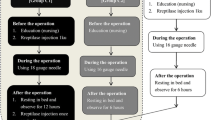Abstract
Purpose
To retrospectively determine the rate of major bleeding complications after solid organ or lung biopsy in patients with hypertension and compare to the rates of bleeding in normotensive patients.
Materials and methods
Following IRB approval, retrospective review of all solid organ and lung biopsies performed at our institution between June 1st, 2013 and October 31st, 2015 was performed. Hypertension was defined as a maximum observed systolic blood pressure of 160 mmHg or greater and/or diastolic blood pressure of 90 mmHg or greater at the time of the biopsy procedure. Bleeding complications were defined using the Common Terminology Criteria for Adverse Events (CTCAE, version 4.0) established by the National Cancer Institute.
Results
4756 total biopsies in 3876 unique patients (median age 60, 57% male) were included. 1488 (31.3%) of these biopsies were performed in hypertensive patients. Fifteen major hemorrhages (CTCAE grade 3 or higher) occurred (0.32%). There were no deaths. There was no significant association between hypertension and major bleeding. The incidence of bleeding in hypertensive patients was 0.40% (6/1488), which was not statistically different than the incidence in normotensive patients (9/3268, 0.28%, p = 0.496). For the subgroup of native renal parenchymal biopsies, the rate of bleeding was slightly higher in hypertensive patients (3/213, 1.4% vs. 1/355, 0.28% in normotensive patients) but remained low, and the difference was not statistically significant (p = 0.188).
Conclusion
The overall incidence of major bleeding after percutaneous biopsy is very low. Hypertension does not appear to significantly increase the risk of major bleeding complications.
Similar content being viewed by others
References
Atwell TD, Smith RL, Hesley GK, et al. (2010) Incidence of percutaneous biopsies and the role of aspirin. AJR 194:784–789
Atwell TD, Spanbauer JC, McMenomy BP, et al. (2015) The timing and presentation of major hemorrhage after 18,947 image-guided percutaneous biopsies. AJR 205:190–195
Kriegshauser JS, Patel MD, Young SW, et al. (2015) Risk of bleeding after native renal biopsy as a function of preprocedural systolic and diastolic blood pressure. J Vasc Interv Radiol 26:206–212
Korbet SM, Volpini KC, Whittier WL (2014) Percutaneous renal biopsy of native kidneys: a single-center experience of 1,055 biopsies. Am J Nephrol 39:153–162
Torres Munoz A, Valdez-Ortiz R, Gonzalez-Parra C, et al. (2011) Percutaneous renal biopsy of native kidneys: efficiency, safety, and risk factors associated with major complications. Arch Med Sci 7:923–931
Shidham GB, Siddiqi N, Beres JA, et al. (2005) Clinical risk factors associated with bleeding after native kidney biopsy. Nephrology 10:305–310
Eiro M, Katoh T, Watanabe T (2005) Risk factors for bleeding complications in percutaneous renal biopsy. Clin Exp Nephrol 9:40–45
Whittier WL, Korbet SM (2004) Timing of complications in percutaneous renal biopsy. J Am Soc Nephrol 15:142–147
Manno C, Strippoli GFM, Arnesano L, et al. (2004) Predictors of bleeding complications in percutaneous ultrasound-guided renal biopsy. Kidney Int 66:1570–1577
Corapi KM, Chen JLT, Balk EM, et al. (2012) Bleeding complications of native kidney biopsy: a systematic review and meta-analysis. Am J Kidney Dis 60:62–73
Peters B, Andersson Y, Stegmayr B, et al. (2014) A study of clinical complications and risk factors in 1001 native and transplant kidney biopsies in Sweden. Acta Radiol 55:890–896
James PA, Oparil S, Carter BL, et al. (2014) Evidence-based guidelines for the management of high blood pressure in adults: report from the panel members appointed to the Eighth Joint National Committee (JNC 8). JAMA 311:507–520
National Cancer Institute (2009) Common terminology criteria for adverse events (CTCAE) version 4.0. Bethesda, MD: NCI, NIH publication 09-5410.
Egan BM, Zhao Y, Axon RN (2010) US trends in prevalence, awareness, treatment, and control of hypertension, 1988-2008. JAMA 303:2043–2050
Sacks D, McClenny TE, Cardella JF, et al. (2003) Society of interventional radiology clinical practice guidelines. Vasc Interv Radiol 14:S199–S202
Nour-Eldin NEA, Alsubhi M, Naguib NN, et al. (2014) Risk factor analysis of pulmonary hemorrhage complicating CT-guided lung biopsy in coaxial and non-coaxial core biopsy techniques in 650 patients. Eur J Radiol 83:1945–1952
Yeow KM, Su IH, Pan KT, et al. (2004) Risk factors of pneumothorax and bleeding: multivariate analysis of 660 CT-guided coaxial cutting needle lung biopsies. Chest 126:748–754
Chakrabarti B, Earis JE, Pandey R, et al. (2009) Risk assessment of pneumothorax and pulmonary haemorrhage complicating percutaneous co-axial cutting needle lung biopsy. Respir Med 103:449–455
Author information
Authors and Affiliations
Corresponding author
Ethics declarations
Conflicts of interest
No conflicts to report.
Research involving human participants and/or animals
All procedures performed in studies involving human participants were in accordance with the ethical standards of the institutional and/or national research committee and with the 1964 Helsinki declaration and its later amendments or comparable ethical standards.
Informed consent
For this type of study formal consent is not required.
Rights and permissions
About this article
Cite this article
Potretzke, T.A., Gunderson, T.M., Aamodt, D. et al. Incidence of bleeding complications after percutaneous core needle biopsy in hypertensive patients and comparison to normotensive patients. Abdom Radiol 41, 637–642 (2016). https://doi.org/10.1007/s00261-016-0653-7
Published:
Issue Date:
DOI: https://doi.org/10.1007/s00261-016-0653-7



